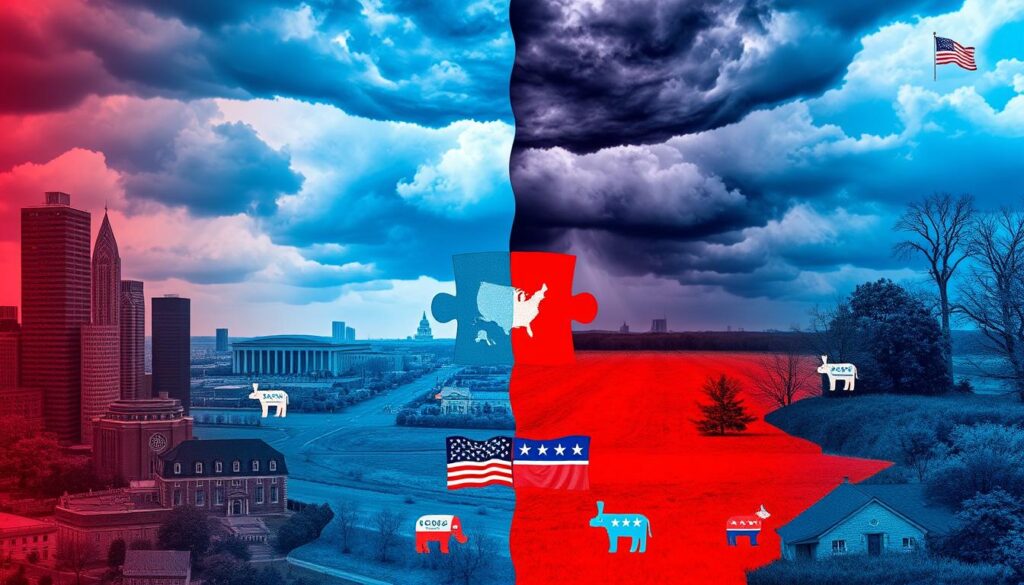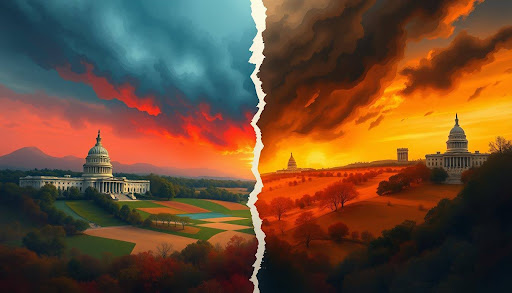what is polarization in government?
In today’s world, political polarization is a big problem. It causes deep divisions in the government. This article will explore why this happens, its effects, and how we can work together to solve it.

Key Takeaways
- Political polarization is when there’s a big gap between political parties and their supporters.
- The media and social media play a big role in making this gap wider. So do deepening differences in beliefs.
- This gap can make it hard for the government to make decisions. It blocks them from solving important problems.
- Polarization isn’t new. It has shown up in different ways throughout history.
- To beat polarization, we need to talk more, find common ground, and tackle the social issues that cause division.
What is Polarization in Government?
Political polarization in government means there’s a big gap between political parties or groups. This makes it hard to find common ground on big issues. It leads to a very charged and opposing political climate.
At its heart, political polarization is about the growing ideological differences and political divisiveness in government. As parties or groups stick to their views, the definition of political polarization becomes clear. It’s a place where two or more sides are very opposed and not willing to change.
This kind of environment makes it tough for lawmakers to work together. They struggle to find solutions that please everyone. Instead, they focus on their own party’s goals and see things as “us vs. them.” This blocks good governance and making laws.
| Characteristic | Description |
| Ideological Differences | Widening gap between political parties or factions on key issues |
| Lack of Compromise | Unwillingness to find a middle ground or negotiate solutions |
| Adversarial Climate | Highly charged, confrontational political environment |
| Gridlock in Policymaking | Inability to pass legislation or implement effective policies |
It’s key to understanding political polarization and its effects on good governance and democracy.
Causes of Political Polarization
Political polarization is a complex issue with many factors at play. The role of media and social media has changed a lot. Now, we have partisan news and online echo chambers that spread extreme views. This makes it hard for people to find true information and see different sides.
Role of Media and Social Media
The media has changed a lot in recent years. We now have more partisan news and social media’s big influence. These platforms spread false information and strong political words fast. This makes the gap between different views wider.
Ideological Differences
Big differences in political beliefs and values also play a big role. Parties with different views on government, economy, and social issues find it hard to agree. People also tend to look for information that backs up what they already believe.
| Factors Contributing to Political Polarization | Impact |
| Partisan media outlets | Amplify extreme views and reinforce echo chambers |
| Social media platforms | Enable rapid spread of misinformation and divisive rhetoric |
| Ideological differences between political parties | Difficulty in finding common ground and compromise |
Together, these factors have made our politics very divided. It’s hard to find solutions that both sides can agree on. Knowing why we’re so divided is key to finding ways to talk and work together better.
Effects of Political Polarization
Political polarization has a big impact on government. It leads to legislative gridlock, where lawmakers can’t agree on laws. This makes it hard to solve important public issues.
Gridlock in Policymaking
When parties are far apart, they don’t work together. This stops the policymaking process. It affects many areas, like healthcare, education, and the environment.
This lack of action erodes public trust in government. It also makes it hard for government to meet citizen needs. This can make people even more unhappy with politics.
| Impact of Political Polarization | Consequence |
| Legislative Gridlock | Inability to address pressing societal issues |
| Breakdown in Bipartisan Cooperation | Erosion of public trust in government |
| Undermined Policymaking Capacity | Limits the government’s ability to respond to citizens’ needs |
To fight polarization, we need more dialogue and compromise. Lawmakers should work together to find solutions. This way, they can help all citizens.
Historical Examples of Political Polarization
Political polarization is not new in the United States. The country’s history shows many times when parties couldn’t agree on big issues. Looking at historical examples of political polarization helps us understand this ongoing problem.
The Reconstruction period after the Civil War was a big example. The Republican and Democratic parties had very different plans for rebuilding the nation. This led to deep partisan divides that made politics very slow for years.
The 1960s were also a time of great division. The civil rights movement, the Vietnam War, and the counterculture created a big gap between the left and the right. This made it hard for lawmakers to work together and pass important laws.
“The failure to find common ground on key issues has been a persistent challenge throughout US political history.”
These examples show that political polarization is a long-standing issue in America. Learning from the past can help us deal with today’s political challenges. It can lead to a more united and effective political conversation.
Overcoming Political Polarization
To tackle the growing divide in politics, we need a variety of strategies. We must promote open talks and encourage people to work together. By doing so, we can find common ground and move towards real solutions.
Promoting Dialogue and Compromise
Starting open and respectful talks is key to reducing political divides. We can do this through town hall meetings and community forums. These spaces allow people from different backgrounds to share their views and find common interests.
Also, we should encourage our leaders to work together. This means rewarding them for finding common ground and making bipartisan decisions. This can help break the gridlock caused by party differences.
Addressing Underlying Issues
It’s important to tackle the deep-seated issues that cause political divisions. This includes reforming campaign finance and redistricting rules. It also means improving media fairness and addressing economic gaps.
By fixing these issues, we can reduce the power of special interests. This helps ensure that politics is more balanced and fair. It also helps bridge the gap between cities and rural areas, easing some of the tensions that lead to polarization.
| Strategies for Overcoming Political Polarization | Description |
| Promote Dialogue and Compromise | Encourage open and respectful discussions, foster bipartisan collaboration, and incentivize compromise among elected officials. |
| Address Underlying Issues | Implement reforms to campaign finance, redistricting, and media regulation, and address socioeconomic disparities to mitigate the root causes of polarization. |
| Empower Citizens | Educate the public on the importance of civic engagement, critical thinking, and bipartisan cooperation in reducing political polarization. |
By focusing on dialogue, compromise, and solving deep-seated issues, we can move towards a more united government. This government will serve the interests of all its citizens.
“The only way to overcome political polarization is through open and honest dialogue, where we seek to understand each other’s perspectives and find common ground.”
Role of Citizens in Reducing Polarization
We all have a role in reducing political polarization. By getting involved and seeking out different views, we can help bring people together. This helps create a culture where both sides work together.
Being active in our democracy is crucial. Going to town hall meetings, contacting our reps, and staying informed are important steps. These actions show we care about solving problems for everyone, not just our own party.
Trying to understand other views and talking respectfully is also key. By listening to those we disagree with, we can find common ground. This is vital for tackling the big challenges we face today.
FAQ
What is political polarization in government?
Political polarization means there’s a big gap between different political views. This makes it hard to agree on big issues. It leads to a very tense political environment.
What are the causes of political polarization?
Many things cause political polarization. Partisan media and social media make extreme views louder. Also, big differences in views on the economy, social policies, and government’s role add to the gap.
What are the effects of political polarization?
Political polarization hurts how the government works. It causes laws to get stuck, making it hard to solve big problems. This makes people lose trust in the government.
Can you provide some historical examples of political polarization?
Political divisions aren’t new in the U.S. The Civil War and the 1960s saw big fights. These times also had trouble finding common ground on big issues.
How can we overcome political polarization?
To fight polarization, we need to talk more and find common ground. We should work on campaign finance, redistricting, and media rules. Also, we need to bridge the gap between cities and towns and tackle economic gaps.
What is the role of citizens in reducing political polarization?
Citizens are key in fighting polarization. They should get involved, listen to different views, and push for solutions that both sides can agree on. By doing this, they can help fix the gridlock and make democracy stronger.







Doubt: How can we bridge the gap in political polarization when extreme views dominate both sides?
Reply: By promoting dialogue, encouraging compromise, and prioritizing common goals over party interests to find solutions together.
“I witnessed firsthand how political polarization stalled progress, with parties prioritizing conflict over cooperation. It’s time for change.”
“Understanding the root causes and historical context of political polarization can provide insights into viable solutions for unity.”